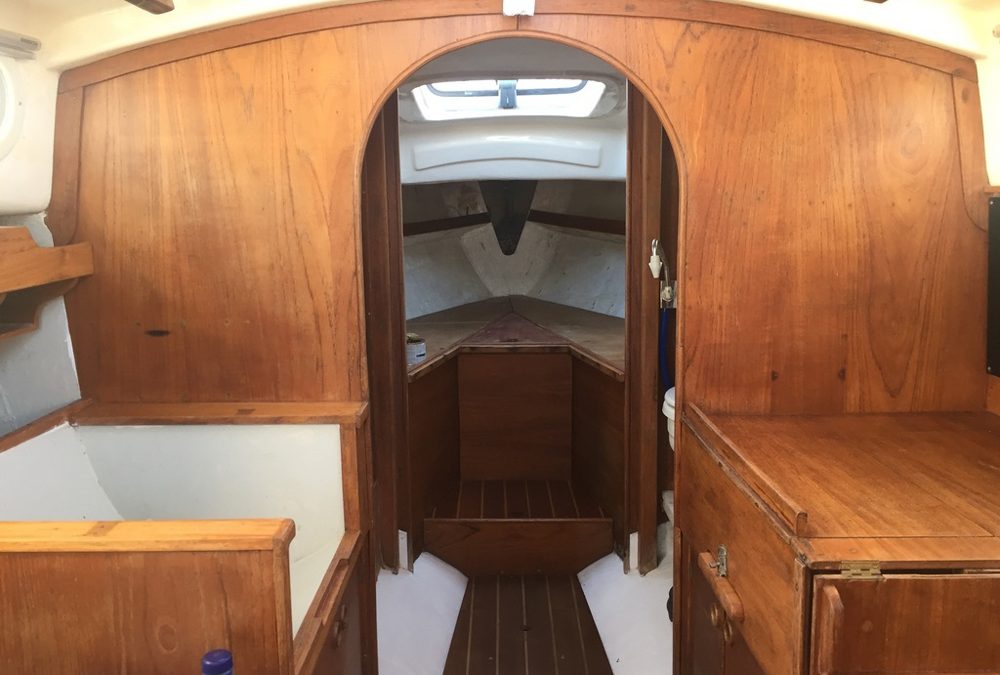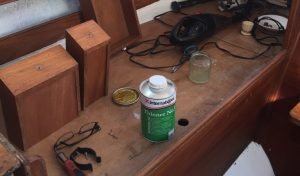Boat interiors on the whole are pretty resilient but over time bulkheads, doors, the cabin sole and surfaces become scuffed, stained and suffer general wear and tear due to the marine environment.
In an ideal world, the best location to undertake such a project is inside a heated boat shed, well protected from the winter weather and with access to power for decent lighting. Unfortunately this was not my recent experience two winters ago, with the boat exposed to the elements and no access to power, but with perseverance I nonetheless achieved some satisfactory results.
Most boat interiors have a combination of varnished and painted surfaces including solid wooden joinery, plywood laminates with thin hardwood veneers and glass reinforced plastic. When making your assessment of what you are going to do, bear in mind that the varnishing process consumes a lot of time, especially if the existing surfaces are in poor shape. This is because, in order to do a decent job, the preparation takes much longer than the brush work itself.
Preparation
Stripping and refinishing interior woodwork is best approached with some caution. Veneered surfaces are usually very thin and it is possible to sand right through a veneer.
- Cleaning – start by cleaning surfaces with a mild bleach such as a hydrogen peroxide and water solution to remove any traces of mould. Baking soda is good for removing oil and grease and a Scotch Brite type pad soaked in ammonia works well. Bleached and darkened timber can be restored with oxalic acid in order to achieve a uniform timber surface. Trial and error works best as it all depends on the actual state of the surfaces and whether the wood has been treated with varnish or oil over the years. Solid teak will often have been treated with oil, while a veneer will more likely to have been varnished. Allow everything to dry before sanding.
- Stripping – if areas of old varnish are cracked and flaking, this will need to be scraped off using a paint scraper. Care needs to be taken not to damage the wood so a plastic scraper is preferable to a stainless steel one – either way proceed with caution. The decision then is whether to use a chemical stripper or proceed to sanding. Rightly or wrongly I chose to use a gel type paint stripper and although this proved a slow, messy process in the end it worked out fine. I wore rubber gloves and a breathing mask to be on the safe side.
- Filling – some of the bulkheads on my boat had had screw holes drilled into them in the past, presumably for securing instruments, fittings or shelving. I filled these with a teak coloured wood filler before sanding.
- Sanding – some people just launch straight in with the sanding which may be fine with timber in good condition, but for those who have been cleaning, stripping and filling you are about halfway through the process. Somewhere between an 80-320 grit aluminium oxide paper is recommended for sanding, depending on the surface condition. It is best to use a sanding block to get an even finish and to finish with a 320 grit paper. Remember to sand along the grain of the wood to avoid scratches showing through the varnish. Once satisfied with the finish, some hours or even days later, remove all sanding dust, which is easier said than done in a confined space. This will most likely entail removing overalls and giving them a good shake outside.
- Thinners – back inside and with dust removed, now brush the sanded surfaces with thinners and wipe with a clean soft cloth. This will remove traces of dust and also any oil residue on the surface of the wood.
Varnishing
- Preparing the varnish – I chose International’s Goldspar Satin varnish, which is recommended for interior use. This can be thinned if necessary using thinners and is easy to apply. Good quality brushes are a must with at least two sizes – for fine work and larger areas. Decant the varnish into an old jam jar and seal the lid of the tin to prevent any dust from getting in.
- Application – when applying varnish on a vertical surface such as a door, brush in a vertical direction. For the first coat, thin the varnish a little as recommended on the instructions label on the tin. Work quickly in a controlled manner, taking care not leave a build up of varnish along the edges. Once you have worked over an area do not be tempted to brush over it again until it is completely dry. If there are any imperfections you notice these are best left until the varnish is dry. Only then can you sand the edges back before applying another coat. Be prepared to apply several coats of varnish to get a good finish, sanding in between coats with 220-320 grit wet and dry paper. Much depends on how much of a perfectionist you are.
Interior painting
If you have invested considerable time and effort varnishing your boat’s interior, then set aside a little extra time to paint the bilges, lockers, galley and heads with a fresh coat of paint. I recommend Danboline bilge paint for this, which is tough, durable and finishes to a thick, hard wearing gloss. After all that varnishing, doing this is a piece of cake by comparison and almost as rewarding as the varnishing.











